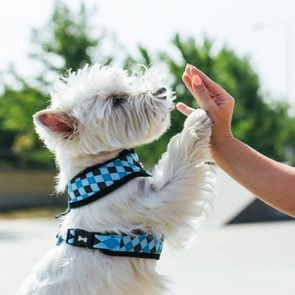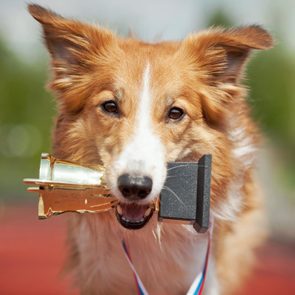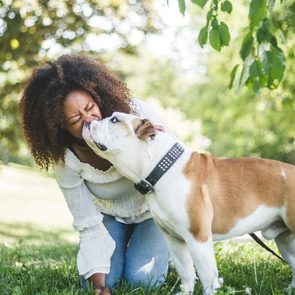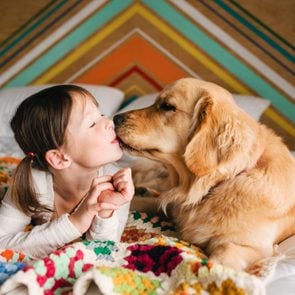How to Train a Dog with Basic Commands, Cute Tricks and More
Updated: Jun. 19, 2024

No matter their age, breed or temperament, every dog can benefit and thrive from dog training
We love dogs for being dogs. Their comforting presence as they lie at our feet. Their cute little grunts and snores when they sleep next to us. And then there are those sweet welcome-home dog kisses when we walk through the door at the end of a long day. With all that abundance of affection, it’s only natural that we tend to forget our pets are dogs, with their own doggy nature. You know what we’re talking about—your dog might root through the trash, chew up your shoes or dig holes in your flower garden.
That’s why it’s important for pet parents to know how to train a dog—an obedient pup equals a safe, healthy and fulfilling life for both of you. There’s so much that goes into training dogs, though—including how to train a puppy, learning how to decode dog behavior and teaching dog commands. But how do you know if you’re doing right or barking up the wrong tree? Lucky for you, our comprehensive guide to how to train your dog, what to do (and what not to do), with input from dog trainers and dog behavior experts, will set you on the right path.
Get Reader’s Digest’s Read Up newsletter for travel, humor, cleaning, tech and fun facts all week long.
On This Page
Why is training your dog important?
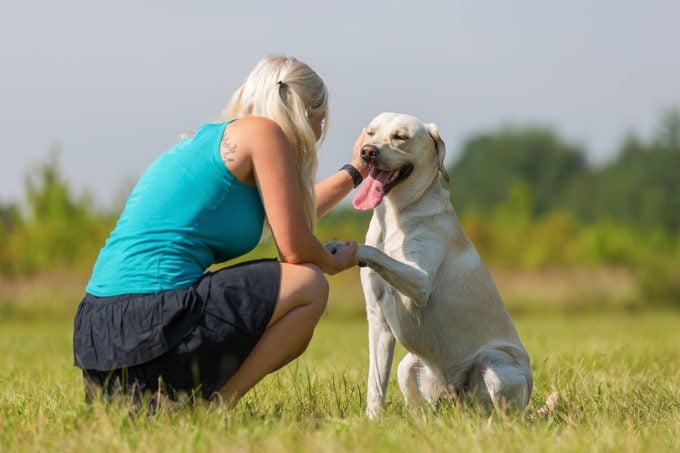
Learning how to train a dog is more than just teaching them to sit or come on command—though those are undeniably important too. Dog training offers many benefits to your pup: It builds their confidence, provides mental stimulation and is especially beneficial for dogs who are anxious or timid. “Positive reinforcement training, when dogs are rewarded for good behavior, helps your pup learn to look to you for leadership rather than creating their own rules,” explains Traci Madson, a certified dog trainer and canine behavior consultant at Pupford, an online dog training academy. As a result, dog training strengthens and nurtures the bond between you and your pup.
Training methods for dogs
Just like with humans, individual learning styles vary from dog to dog. Experiment with different training methods, or a combination of methods, to find out which works best for your pup. Note that the best method for the same dog may vary, depending on the lesson of the day.
Positive reinforcement
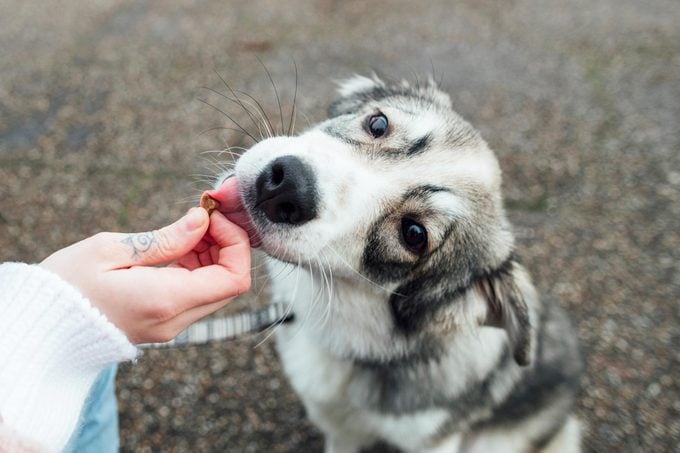
“This method focuses on rewarding good behavior to reinforce the behavior you want to encourage, rather than punishing unwanted behavior,” says Trevor Smith, a certified professional dog trainer at Pupford. For example, if your dog stops and looks at a squirrel without lunging at it, offer them a treat and heaps of praise with affection.
Clicker training
Clicker training is a positive-reinforcement-based method where the “click” sound marks the good behavior. “Follow clicking with an immediate delivery of treats to your pup—this creates a clear and consistent message to your dog,” says Trevor Smith. Why use a clicker if you’re still offering treats? It’s faster for us humans to click than it is to reach in a pocket or pouch to grab and then deliver a treat.
If you decide to use a clicker for training, condition your dog to the clicker sound before you start. To do so: Have 10 treats at the ready. Then do a rapid fire of clicks and treats. (Be sure your dog finishes eating the treat before clicking again.) That’s it. Your dog doesn’t have to do anything special and will learn quickly that “click” equals treats!
Model training
Dogs are very social and tend to learn through observing and imitating other dogs. “Model training is a method where a trained dog serves as a model to demonstrate desired behaviors, with the goal being that the learner dog imitates and learns from observing the trained dog’s actions,” says Trevor Smith. Here’s an example: Max knows how to fetch, but Bella doesn’t. In model training, you would begin by playing a rousing game of fetch with Max, then encourage Bella to imitate the behavior by saying “fetch” and guiding her to the ball. Praise her and give her a treat even if she doesn’t bring back the ball. Then play fetch with Max again, inspiring Bella to join the fun. Next, play fetch with both dogs all while praising the pups.
What to know before training your dog
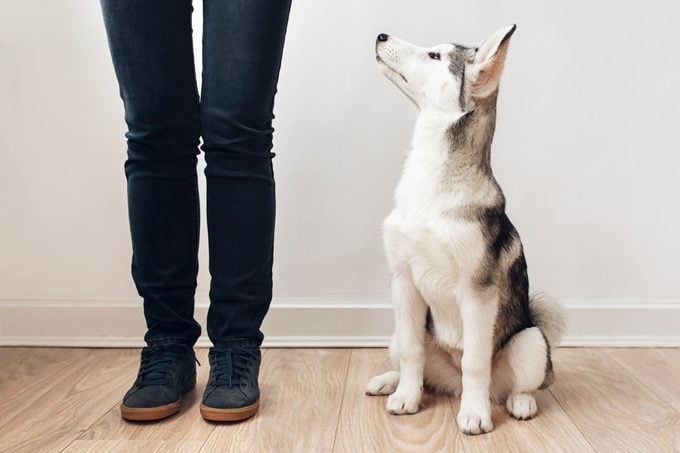
Unlike training cats—who do what they want, when they want—dogs (well, most of them) are eager to please you and way smarter than we think. You see, dogs are pack animals, and it’s in their genetic makeup to follow their leader—aka, pet parent. Still, as willing and capable as they are to train, there will be days they’re just not into it. Before you start training:
Size up their energy and mood
When considering how to train a dog, it’s best to observe your dog first for any subtle physical cues or facial expressions that show they’re not interested in training. Look for signs of doggy anxiety and stress, such as short licks of the nose, hyper-vigilance or yawning when they’re not tired, or ears that are pointed back. “We want our dogs to enjoy training, so making sure they are relaxed and happy before getting started is key,” says Renee Rhoades, a certified dog behaviorist and the founder of R+Dogs.
Time it right
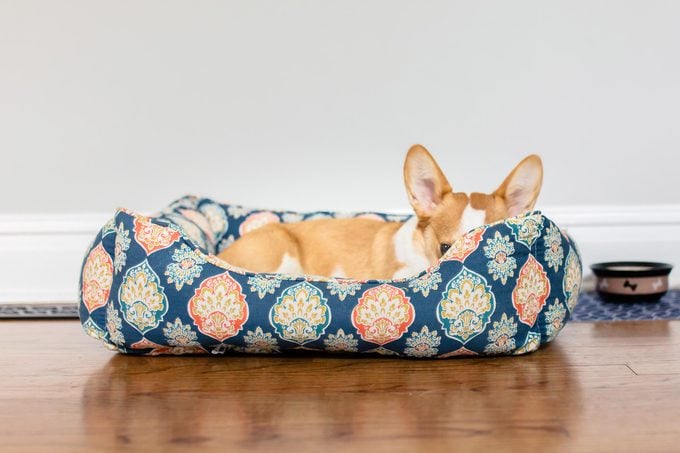
You know that saying, “Let sleeping dogs lie”? Heed this proverb before you attempt to train a dog. “Train when your dog has the most focus,” says Ali Smith, a dog trainer and the founder of Rebarkable dog training. Don’t wake them up to train, though training them shortly after they wake up from a nap is OK. The ideal time to train is before mealtimes, when they are a little hungry and will be especially food-motivated.
Reward them for relaxing
Yep. You read that right. When they’re chillin’ in that adorable dog sploot, toss them a treat. “One of the biggest things we forget is that most of our dogs need to be taught how to ‘switch off,’ particularly active breeds,” says Ali Smith. Oddly enough, not all dogs automatically nap or sleep when they’re tired. Giving them a reward while they are relaxing essentially tells them you like what they’re doing and to do it more.
Be patient
In general, it’s easier for dogs to learn what you want them to do, but you’ll probably need more patience when it comes to curbing undesirable behaviors. Training dogs to relinquish an established habit, such as jumping on people, and instead politely “sit” when greeting a visitor, takes consistent training and more of it too. But training sessions shouldn’t be drawn out. For puppy training, try three to five minutes and then extend to 10 to 15 minutes when they build more stamina. Limit training for adult dogs to about 15 minutes.
What you need to train your dog
No matter which training method you decide to use, there are a few products that will come in handy as you learn how to train a dog. Almost every dog loves to learn, but high-value treats (ones that make your dog drool and go bonkers) are essential in dog training, especially when you’re working with the dogs that are hardest to train. Reserve the high-value treats for training only and they’ll stay interested and motivated. Here’s what you need to train your dog:
- Clicker
- Long lead
- Harness
- Treats
- Treat pouch
How to train your dog to follow commands
It’s essential to train a dog to follow commands, because they’re the key to co-existing peacefully (and politely) with humans and other animals. Not to mention, they can keep your dog safe and out of harm’s way.
How to train a dog to sit
How to train your dog to sit is one of the most important commands to teach because you’ll use it multiple times daily. It comes in handy when you’re placing down their dinner and want them to wait patiently, opening the door to leave and don’t want them to rush it, crossing the street and don’t want them to rush into traffic, and it’s a polite way of greeting people instead of jumping.
How to do it:
Training dogs to sit involves “shaping the behavior,” which means breaking it down into steps. To begin, sit or kneel on the floor in front of your dog. Place a treat near their nose, then raise it up over their head. Your dog’s nose should follow, causing them to naturally put their butt down on the floor. When their butt is on the floor, click or praise them (“good girl/boy”) and give them a treat.
Once they nail this, you can move on to the verbal cue training: Raise the treat up and over their head like you did before. When their butt hits the floor, click and say “sit” and give them a treat and praise. Repeat until they sit on command (this may take more than one session).
Sometimes younger puppies struggle with sitting at first. “Puppies’ muscles are still catching up to their bones, and sometimes they can have a ‘sloppy sit,'” says Ali Smith. And some dogs may sit perfectly fine on the carpet or the grass but don’t like the feeling of their paws slipping on a tile or wooden floor. If your dog fits into either category, be patient and don’t demand perfection.
How to train a dog to stay
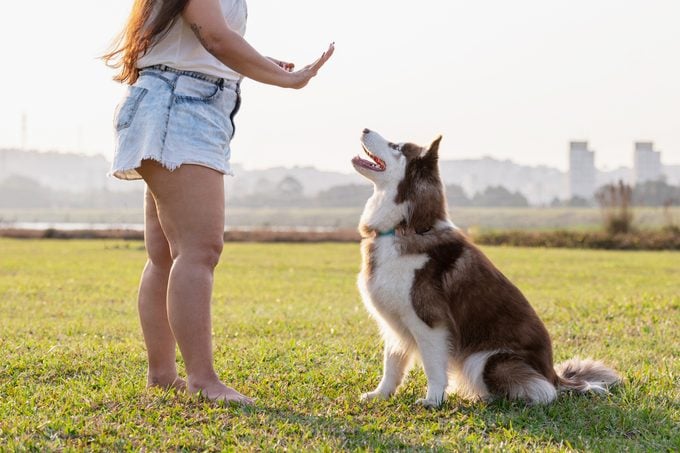
Training dogs to “stay” can be challenging. After all, dogs follow you everywhere, even into the bathroom. So before you even attempt to train your dog to stay, your doggo must have acquired the “sit” command.
How to do it:
Here’s a key tip regarding how to train dogs to stay: Use distance, duration and distractions, but only introduce one at a time. So if you use distance, for example, don’t add duration to the mix.
“Stand in front of your dog and say ‘stay’ while putting your hand out in front of them, like a stop signal. Count to five and then click and treat, tossing the treat away from the dog and saying ‘free’ to release,” says Madson. Next, have your dog sit and say “stay.” Step back to increase the distance and count to three, then go walk back to them to reward them with a click and treat.
Phase two: To advance, take larger steps back and repeat the same process. “Remember, if you add distance, don’t add duration and vice versa,” Madson says. If your dog breaks the stay, say “try again” and get them to sit. “The dog should only break a stay if they are released or called to you from a distance (after they learn ‘come’), so I mix it up to make sure the dog is paying attention and only breaking when they hear ‘free,'” Madson explains.
Phase three: “For the next step, I practice walking around the dog and returning to their front side to click and treat.” Fair warning: This phase may take several training sessions before you complete the circle around your dog. They might break the stay, especially when you are behind them. (What’s going on back there?!) Every time you add another step, repeat the click-and-treat process. After acing “stay” at home, try it in a public setting that has more distractions than your backyard, but make the sessions easier by reducing the distance and duration.
How to train a dog to come to you
“Come!” is one of the most important commands dogs can learn to keep them out of harm’s way, be it a moving vehicle or another dog. You’ll also want your dog to obediently return to you when it’s time to leave the dog park or you want them to come back inside from our fenced-in yard. It’s also nice to have a dog come on command when you’re in the mood for some canine company.
How to do it:
For the first phase, practice indoors in a calm, quiet space. Begin with a short distance of three to five feet between you and your pup. Then turn on the fun. “Get excited, get bouncy, and call your dog’s name and say ‘come!’ When they get to you praise and reward,” says Ali Smith. Each time you practice, increase the distance.
Phase two: Grab a harness and a long lead/leash, at least 10 feet long, to keep your pup from running off. Begin with shorter distances between you and your pupster, and slowly increase the distance until you’re at the end of your long line. Follow the same steps as in phase one, excitedly calling your pup’s name and saying “come.”
Once they’ve mastered longer distances, let go of the leash to give them more freedom, with the confidence of knowing you can quickly pick the leash back up if needed. Eventually, you can train without the lead. Something to keep in mind is that independent dog breeds will likely struggle with learning “come” more than others, cautions Ali Smith.
How to train a dog to leave it
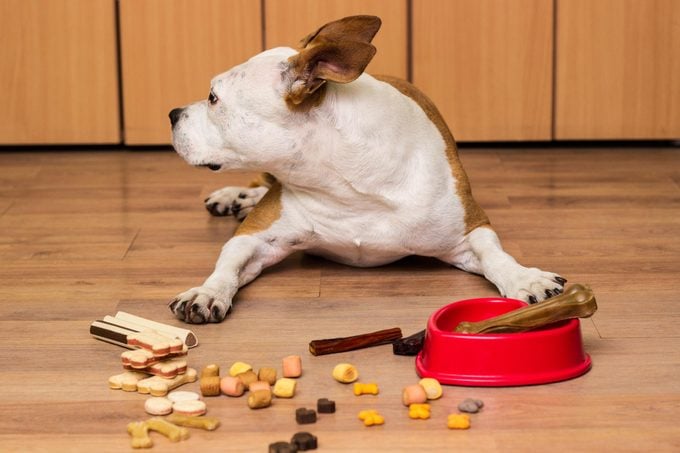
“You can’t be serious. You expect me not to wolf down the chicken wing that human just dropped?” Your dog might not understand that “leave it” is for their own safety—or to save your shoes from becoming a chew toy—but you’ll be so glad you trained your dog to leave objects on command.
How to do it:
“Training a dog to leave it involves teaching them to ignore or relinquish items they find interesting or enticing,” says Trevor Smith. That’s no small feat! Begin by holding a mediocre treat in one hand and presenting it to your dog. When they show interest in the treat, firmly say “leave it,” close your hand and withhold the reward. When they ignore the hand, reward them with a high-value treat from the other hand. It’s critical to have an irresistible treat as the reward and something ho-hum in the “leave it” hand.
“Repeat this process consistently to reinforce the concept of leaving the item,” says Trevor Smith. “Gradually increase the difficulty by placing the treat on the floor and covering it with your hand, rewarding your dog when they resist the temptation.” Practice in various settings, gradually adding distractions to generalize the command.
How to train a dog to heel
Training a dog to heel means they walk directly next to you, without pulling. “Asking your dog to ‘heel’ is comparable to asking a toddler to hold your hand,” says Heather Gillihan, director of learning and development at Zoom Room dog training gyms.
How to do it:
Start off-leash inside your home. Let your dog know you have high-value treats and start walking while looking at your dog. They’ll be motivated to catch up with you to get the treats. “As soon as they are by your side and looking at you, say ‘yes!’ and quickly deliver a treat, while still moving forward. They will again catch up and walk next to you. Mark it again with a ‘yes!’ and treat,” says Gillihan. Note that you are not even saying “heel,” or their name, just “yes.” Your dog is learning where the “reward zone” is at this point. Once your dog is great at remaining by your side and in position for at least six to eight steps, you may add the verbal cue “heel” and then say “yes” and toss a treat.
Phase two: Repeat the process but decrease the steps you take each time, beginning with five steps down to one. So, you take five steps, say “heel,” then say “yes,” toss a treat and repeat until you get down to one step. “You want to ensure that your pup is doing the behavior correctly and consistently so that they tie the word ‘heel’ with the correct behavior,” Gillihan explains. Eventually, you can vary the speeds and try making turns. “Remember always to give your ‘release word’ (‘all done,’ ‘free,’ etc.) to let them know when the ‘game’ is over.” Once they’ve mastered this inside, move outside into a fenced-in yard.
Important things to teach your dog
How to potty train a dog
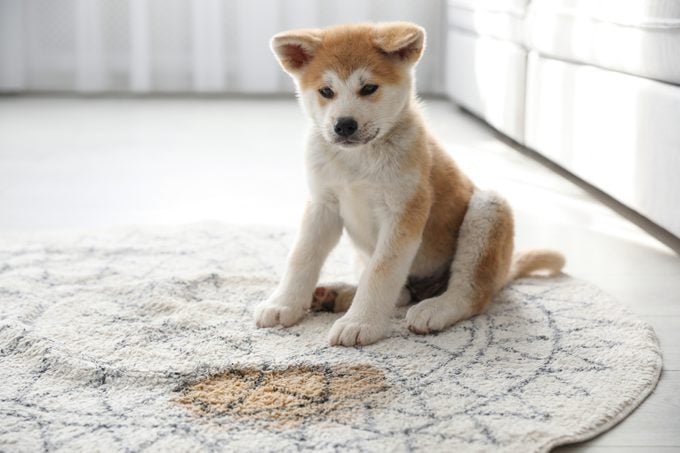
Potty training is a true test of patience and consistency. Some pups pick it up within days, while others can struggle for months. “Smaller dogs may take longer to potty train since they have smaller bladders, which can lead to more accidents,” says Madson. No matter the size, every dog learns at their own pace.
How to do it:
Consistency is the single most crucial factor when it comes to potty training, so make a walk schedule and stick to it. “For puppies, I recommend having potty breaks every 45 to 90 minutes, and then every 90 minutes to three hours, as your pup matures,” says Madson. A consistent mealtime schedule also helps with potty training success. “Dogs are creatures of habit and like to have a routine, including when they eat and when they use the potty.” Remember to immediately reward them with heaps of praise and delicious treats after they potty outside.
When the inevitable accident happens, simply clean up the mess and move on; do not yell at or physically punish your pup, because they won’t connect their accident with something bad due to the time lapse. “The window for your pup to associate an act with a reward or punishment is only five to 10 seconds, so any reinforcement after that is pointless,” according to Madson, who goes on to say that she never recommends punishment.
How to crate train a dog
Even if you don’t plan to use a crate daily, your pup may need to stay in a crate while they are receiving medical treatment at the vet, when they go to a dog groomer or for dog boarding.
How to do it:
The key to successful crate training is to make the crate a pleasant and inviting space. Place the crate where you and your pooch already enjoy hanging out together, put comfy bedding inside and drape the crate with a sheet on three sides only, so your pooch can still see you. Secure the door open so it doesn’t accidentally close and startle them when they venture inside. Begin feeding meals inside the crate. When it’s not mealtime, you can put a food puzzle inside the crate, but you may need to tie it to the crate itself so your dog doesn’t grab it only to run off somewhere else to enjoy it. Just how long can a dog stay in a crate? “Once your dog is choosing to spend time in their crate, you can begin closing the door for very short periods of time (seconds at first), then gradually increase the time to prevent them from feeling stressed or fearful,” says Gillihan.
How to leash train a dog
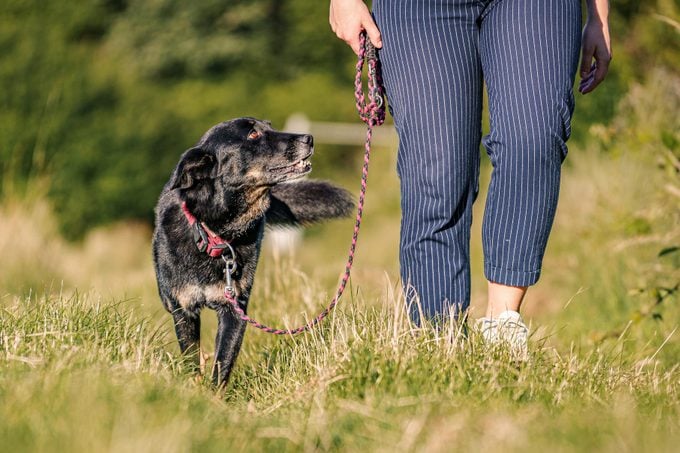
News flash! As common as it is to see a dog walking on a leash, doing so doesn’t come easily for dogs. “Dogs naturally walk faster than us and zig-zag rather than progress in a straight line. It is best to approach leash walking with an attitude of ‘I don’t enjoy being pulled’ rather than a ‘heel’ walk,” says Rhoades.
How to do it:
The central key in training a dog to walk on a leash is knowing your pup naturally loves to be near you. “With that in mind, you can teach your dog that being near you is even better than they think, giving them yummy food rewards whenever they hang out near you,” says Rhoades. Begin training in a low-distraction environment, like inside your house. Attach the leash and hold it while letting your dog wander around. Once they hit the end of the leash, make a sound to get their attention and bring them back to you. Reward them with treats and/or praise. Practice this for five to 10 minutes.
Phase two: In the next session, take a few steps, and if your dog is sticking nearby with a loose leash, reward them. Keep practicing taking small steps and rewarding when they choose to stay close. “Once your dog is able to move with you as you move around the room, you will be ready to go out to a more distracting environment like the backyard. Repeat the same process, keeping the sessions five to 10 minutes long. It’s perfectly normal and acceptable for a dog to sniff while on the leash; the goal is not to pull you. Once they’ve mastered walking around the backyard on a loose leash, try walking on the sidewalk for a short distance. Gradually add more distance each time you go out. “Be patient with your dog if you take them to a new area, because your dog is likely to struggle with the novelty of a new environment. Before long, your dog should come to understand that being on a leash is restrictive, but that restriction isn’t a negative,” Rhoades says. You might want to buy a no-pull harness to keep pressure off your dog’s neck and make the walk more enjoyable for you both.
How to train your dog to do tricks
Teaching tricks is the peanut butter frosting of dog training. It’s a fun way to spend time with your canine, plus it ignites their brain, improves concentration, curbs problem behavior and helps expend their energy so they can snuggle with you on the sofa when it’s time to relax.
How to train a dog to shake paws
Before your pupster learns to shake paws, they must master the “sit” command. Once they do, you can teach them how to shake paws when they greet your friends.
How to do it:
Slide a treat around on the ground with your hand while your dog follows it with their nose. Your dog will probably paw at your hand to try to eat the treat. When they do, immediately click and treat them. “Do that several times until your dog is consistently pawing at your hand. Then raise your hand off the ground to get your dog to move their paw higher, and say ‘shake’ as the dog is lifting their paw to stop your hand,” says Madson. Eventually, you can fade out the lure of the treat in your hand.
How to train a dog to roll over
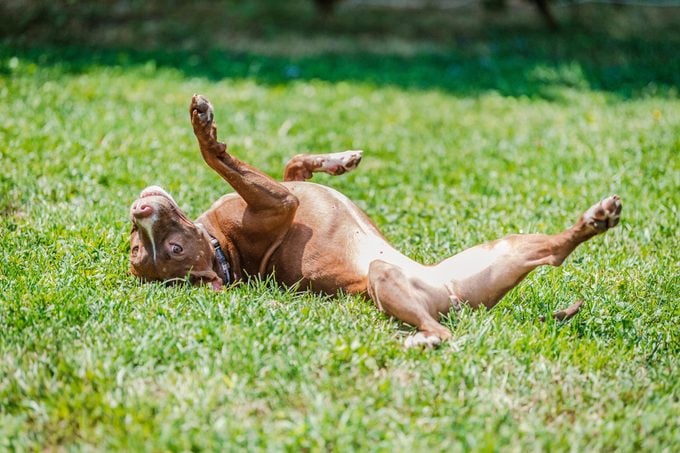
Training a dog to roll over is a cute and fun way to keep their noggin’ active and their tail waggin’.
How to do it:
When your dog is lying down, use a treat to lure your pup onto their side by putting it near their shoulder. As soon as they lie on their side, mark and reward. “Grab a new treat, then move it toward their belly and reward them as they move in the right direction. Keep luring your pup and rewarding until they’re on their back,” says Madson. Mark and reward by offering treats on the other side. Repeat this motion and incorporate a cue word like “roll over” to perform the trick on demand.
How to train a dog to spin
This fun party trick will impress your friends and endear your pup to any strangers the two of you meet.
How to do it:
“With your dog in front of you, use a treat in your right hand and position it directly in front of their nose to slowly lure them into turning a 360-degree clockwise circle—a right circle from your perspective,” says Gillihan. Your dog might not make the full circle right away. “Just take them as far as you know they will go, give an enthusiastic ‘yes!’ and treat.” Repeat this process several times. On the next attempt, go slightly further than before, saying “yes!” and treat. Repeat several times before continuing the progression. “Before you know it, you will have a dog that loves to offer a spin when cued!”
How to train a dog to fetch
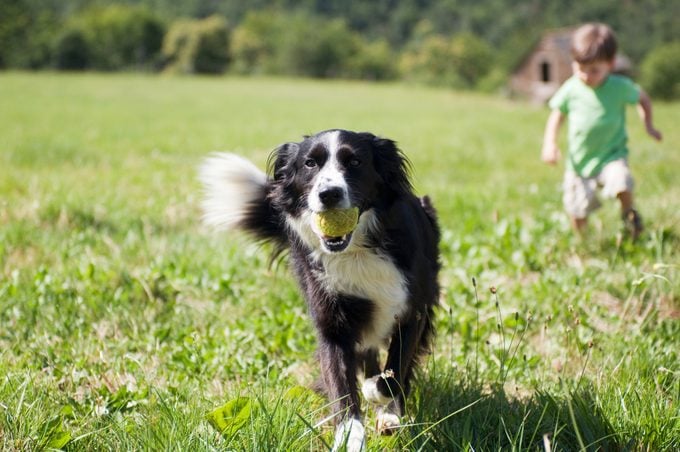
This may come as a shock, but not all dogs are natural fetchers. If your dog is lazy or otherwise isn’t into it, it may be more difficult to train them how to fetch. But that’s OK, because there are plenty of other tricks to learn!
How to do it:
To teach your dog to fetch, begin in a small room so your pup doesn’t take the toy and make a run for it. Ramp up some excitement about the toy by shaking it and moving it around, enticing your dog. Now, toss the toy about a foot away. As soon as your pupster grabs the toy, offer a treat in exchange for the toy. “Repeat this process several times so that your dog understands that grabbing the toy and then giving it back to you earns them a treat and another chance to play the game,” says Gillihan. When your pup masters this short distance, try tossing the toy a little further until you can toss the toy the length of your small room. Move to a larger room when your pup consistently brings the toy back. “Keep the training sessions short—you want to end the game before they do!”
Dog behavior training
How to stop a dog from barking
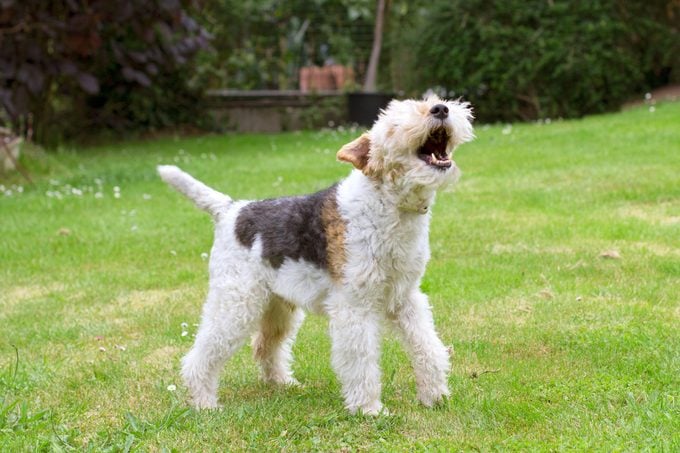
Finding out how to train your dog to stop barking requires a little detective work to determine what triggers the barking. Do they bark at the delivery person? The doorbell or other dogs? Whatever the reason, you can teach your dog to stop by desensitizing the trigger, creating a positive association by responding calmly to it and modeling to your dog to remain calm.
How to do it:
Before we get to the steps, it’s vital to understand what’s going on in your dog’s brain. Let’s say the doorbell is the trigger for the barking. A typical scenario unfolds like this: doorbell rings > dog barks > mom/dad answers the door > excitement happens.
The goal of desensitizing the trigger looks something like this: doorbell rings > dog remains calm > mom/dad rewards > answers the door.
You can swap the doorbell for any trigger, but we’ll stick with the doorbell for this example. Find a doorbell sound (or record your own). “Pick a time when your dog is already relaxed, and start by playing the doorbell sound at a volume level that doesn’t trigger your dog’s barking but is loud enough to grab their attention,” says Ali Smith. Then reward. Gradually increase the doorbell volume over multiple sessions and reward your dog for remaining calm.
More serious reactions like barking and lunging at other dogs may require professional support, says Ali Smith.
How to stop a dog from jumping
“Dogs often jump as a way to get attention from other dogs and us,” says Trevor Smith. But even when they’re doing it because they’re happy to see you, those jumps come with paws and nails that scratch. “To prevent jumping as a greeting, you want to increase the ‘sit’ behavior.”
How to do it:
Regularly approach your dog and ask them to sit, then follow with a reward. “When your dog learns that when they sit, they get rewarded, it can make them more likely to do so than to jump up on you,” says Trevor Smith. If they start jumping, you should ignore them and turn your back on them. But that might not work for extra excited pooches. “Use the ‘sit’ cue to redirect their behavior, and reward them immediately when they do,” he says.
How to stop a dog from digging
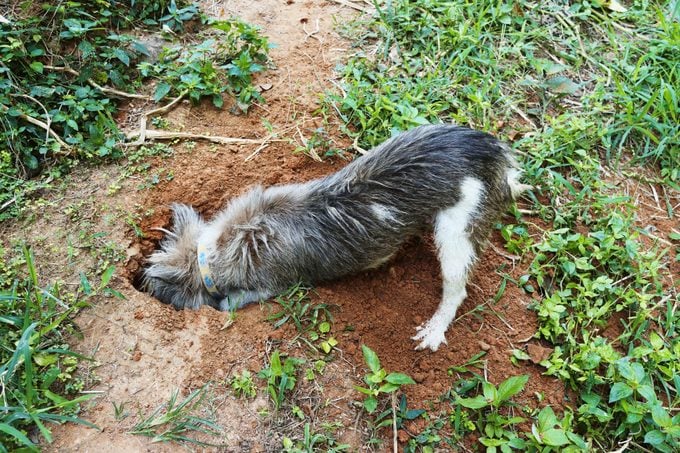
Digging, as destructive to your yard as it can be, is a natural canine behavior that stems from your pup’s survival instincts, such as burying bones in the yard to chew on later. But dogs also dig out of boredom, lack of exercise or too much freedom. “Addressing these issues can help deter your dog from digging,” says Trevor Smith.
How to do it:
If you’ve done your best to engage and exercise your pooch and they’re still digging, consider creating a doggy digging zone where they can dig to their heart’s content. “Border off an area with rocks or a fence and fill it with material easy for your dog to dig, like sand or dirt,” he says. “Bury some of their favorite toys in the pit and reward them once the toys are found,” says Trevor Smith. If your pup continues to dig outside their area, redirect them to the pit and continue encouraging them to dig where you want them to.
How to stop a dog from peeing in the house
Dogs pee in the house for myriad reasons; before you can stop the behavior, it’s essential to figure out why they’re doing it. Take your pup to the vet to rule out health issues such as aging, arthritis, urinary tract issues or dementia. If those aren’t the cause, look for behavioral-related reasons. Dogs may pee in the house when they are anxious or scared; it could be that something spooked them or there’s been a change in the home, such as a new pet or baby.
How to do it:
Begin by revisiting potty training 101. If your dog has been going out every six hours, start taking them out every two to four. “Be on the lookout for any body language that indicates your dog needs to go,” Rhoades says, then take them out, pronto, if and when you spot it. Individual signs vary, but actions like pacing, circling, sitting next to the door, staring at you and panting could all mean “I gotta go!” Then, “when your dog goes to the bathroom where you would like, offer lots of calm but happy praise and their favorite treats,” she says. Slip-ups will happen, but do your best to ignore them, as it’s super important not to get angry and raise your voice or hit or shake your dog. They have no idea why they’re being yelled at, and it stresses them out. Do clean up dog pee thoroughly so any lingering scent doesn’t entice your dog to do it again.
How to stop a dog from eating poop

Yuck! Why do dogs eat poop to begin with? Experts don’t have a definitive answer, but some theories suggest dogs eat poop to get missing nutrients. Or mama dogs might carry on the evolutionary trait of eating their puppy’s poop to eliminate odors from nearby predators. Whatever the reason, it’s actually normal and something you shouldn’t punish your dog for doing.
How to do it:
The first step is to remove the temptation by disposing of the poop in your yard and avoid walking your dog in areas where there is poop. Next, “make finding poop, but not consuming it, the best thing your dog has done,” says Rhoades. Try this on those occasions: Immediately reward your dog with a super tasty treat they can’t resist and lots of praise. “You can also try to teach your dog a ‘leave it’ cue if you haven’t already,” she says. If your dog continues to eat poop despite all your efforts, make an appointment with the vet to make sure there isn’t an underlying health issue.
How to stop a dog from biting
Before we dive in, it’s essential to recognize that puppy nips and bites are a normal part of learning bite inhibition, meaning a dog’s ability to control the force of their mouthing. Just watch dogs at the dog park, and you’ll likely see them nip each other when they’re playing. Occasionally, a dog gets bit too hard and yelps and stops playing. The yelp startles the biter and they stop playing too, usually only momentarily, before both start playing again. These interactions actually help teach dogs to control the intensity of their bite when playing with other dogs. The same philosophy can be applied when dogs bite humans.
How to do it:
When you’re playing with your dog and they nip too hard, immediately and abruptly leave, going into another room and shutting the door. Stay there for 30 seconds, then return as if nothing happened. If your dog nips you again, repeat the process. This teaches your dog that biting you too hard makes you go away. “Since that is not the dog’s goal, they will learn to control their bite pressure if they want to continue playing with you,” says Gillihan.
It’s important to note that playful biting is different from aggressive-behavior biting. When a dog is aggressive, they tend to have a stiff body and show their teeth and deliver a quicker and more painful bite. If this sounds like your dog, call a certified animal behaviorist for help.
What to do if you’re struggling with dog training
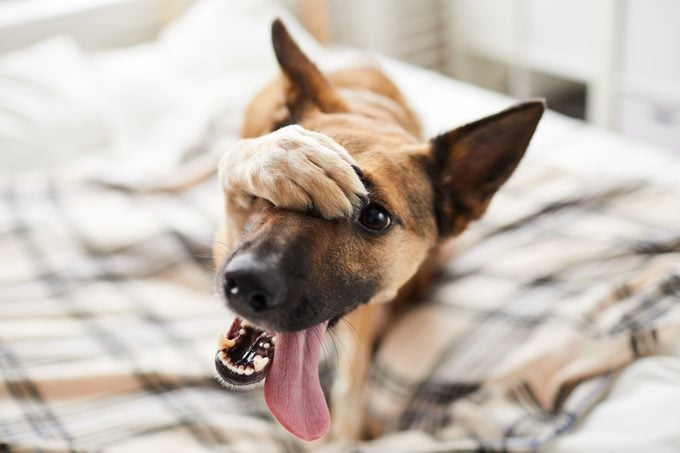
Your dog is still running off with the ball instead of returning it to you and jumped so forcefully on your great-aunt the last time she came to visit they practically knocked her over. As discouraging as it is to not see your training lessons pay off, cut yourself—and your pup—some slack and don’t give up. “Dog behavior and training are complex,” reminds Rhoades. “When you are struggling with your dog’s behavior, it’s incredibly important to remember that being the guardian of a dog can be very challenging, especially at the beginning of your relationship.” With that in mind, follow these tips:
- Be patient and consistent. “Training takes time, and each dog learns at their own pace. Set realistic expectations to avoid getting frustrated or discouraged,” says Trevor Smith. Break down the training tasks into small, manageable steps, and celebrate every success no matter how tiny.
- Remember: Dogs aren’t stubborn. Sometimes they just don’t understand what you are asking them or the process isn’t sinking in. For example, in the early days of training, don’t be surprised if your dog ignores the “come” command when they have a squirrel in their sights.
- Take a break. Your dog might not be the only one that needs a short respite from dog training. When things aren’t going well, your dog can sense that you’re getting frustrated. Call it quits for the day and do something fun with your dog or simply snuggle on the sofa together.
- Hire a pro. “Consider seeking guidance from professional dog trainers or attending dog obedience classes to gain valuable insights and support,” says Trevor Smith. Be sure to seek out a trainer who actually teaches you how to train your dog rather than keeping you on the sidelines.
About the experts
- Traci Madson is a certified professional dog trainer (CPDT-KA) and certified behavior consultant canine-knowledge assessed CBCC-KA at Pupford Academy with more than 20 years of experience. Through her volunteer work with the Humane Society of the United States and other rescue organizations, Madson discovered a passion for helping dogs overcome fear-based behaviors so they can remain safely in their homes with their owners. Madson is the proud parent of three pit bull mixes, Maddie, Jade and Willy Wonka Tonka.
- Trevor Smith is a certified professional dog trainer (CPDT-KA) and certified canine fitness trainer at Pupford who has been educating and training dogs for more than two decades. His focus is on positive-reinforcement training to help people genuinely enjoy their life’s journey alongside their furry friend. Trevor Smith is a pet dad to 10 adorable and wicked-smart dogs: Enya, Meiko, Sushi, Suki, Noah, London, Disney, Jade, Bolt and Friday.
- Renee Rhoades is an award-winning, multi-certified dog behaviorist with a master’s degree in animal welfare science and ethics. She is the founder of R+Dogs, a virtual dog behavior consultancy offering private coaching and online courses. She specializes in coaching dog guardians to help their fearful and fired-up dogs overcome aggression, reactivity, anxiety and hyperactivity. She also co-hosts Doglogical, a podcast on dog behavior. Renee is a dog mom to Nero, a whippet/border collie, and Lycan, a German shepherd.
- Ali Smith is a multi-award-winning online dog trainer certified through the United Kingdom–based Institute of Modern Dog Trainers and the founder of Rebarkable.com. She is passionate about helping puppy parents get things right from the start through positive-reinforcement training. Ali Smith is a pet mom to coonhounds Shelby and Lucy, and Indie, her formerly reactive German Shepherd, who inspired her to become a trainer.
- Heather Gillihan, CPDT-KA, is the director of learning and development at Zoom Room dog training gyms and an American Kennel Club Evaluator. In addition to obtaining Canine Good Citizen and Therapy Dog certifications with her own dogs, Ripley, Dawson, Tessa and Link, Heather has pursued and obtained competitive obedience and agility titles for multiple dogs.




















